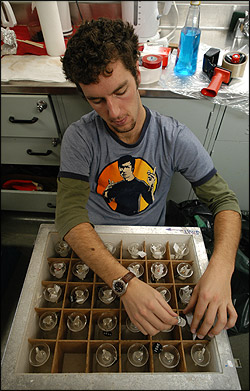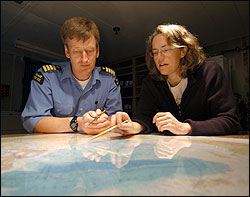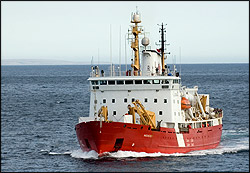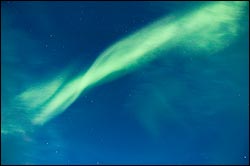Please note: You are viewing
the unstyled version of this website. Either your browser does not support CSS
(cascading style sheets) or it has been disabled. Skip
navigation.
Chris LinderAugust 31, 2005
Over the course of the last 31 days, the WHOI/IOS mooring team recovered and redeployed all of the subsurface moorings. The profiling CTDs on moorings A, B, and C collected 972 CTD casts worth of data since they were put in the water last summer. The other instruments--upward looking sonar and bottom pressure recorder--performed equally well. We established ice buoys at two locations; they are already happily sending their data back home. The Institute of Ocean Sciences CTD team collected a mountain of data; the CTD traveled up and down through the water column 50 times, traveling a total of 102 kilometers. In addition, Masuo Hosono from the Japan Agency for Marine-Earth Science and Technology launched 53 XCTDs. The water sampling crew drew samples from 895 Niskin bottles. The data from this expedition will tell a story. More than mere numbers, they are like the pieces of a puzzle that waits to be completed. We have already seen the effects of climate change in Arctic waters from the 2003 and 2004 Beaufort Gyre expedtions. How will 2005 compare? What are the implications for our global climate? This data will help us answer these questions and many more. We couldn't have done it alone, though. Captain Potts and the crew of the Louis got us to the finish line against all odds. And when I say crew I mean everyone, from the folks who drove the ship to the engineers who kept the Louis moving, the deck department that helped us get those moorings back, and the stewards that took care of us. There are so many other people who contributed to the success of this expedition, I scarcely know where to begin. Thank you to the National Science Foundation, in particular Thomas E. Pyle, Section Head, Arctic Science Section of Office of Polar Programs, Simon N. Stephenson, Research Support and Logistics Manager, Neil R. Swanberg, Arctic System Science Program Director, Denis Conlon, Cyberinfrastructure and Sensors Program manager, and Alexandra Isern, Division of Ocean Sciences, Ocean Technology and Interdisciplinary Coordination. Thank you to William Curry, Director, Ocean and Climate Institute, Woods Hole Oceanographic Institution for funding of 2004 expedition to the BG. Without the Institute's help we would not have been able to redeploy the moorings last year. Thank you to the Canadian government, especially Marty Bergmann, Director, Arctic Science Program Development, Canada. Thank you to our colleagues at the Institute of Ocean Sciences, Fiona McLauglign and Eddy Carmak, for their important role in the expedition planning from Sidney, British Columbia. Thank you to John Toole, Woods Hole Oceanographic Institution, for his constant help and support during expedition planning, preparation, MMP and ITP data processing, advice, and analysis. Thank you to Dina Pandya, who worked seven days a week to make sure the dispatches were posted to the website. Last but not least, thank you to everyone who visited and enjoyed this website. While fighting writer's block on this last dispatch, the Arctic sent me the perfect finale. Catherine Lacombe paged me from the bridge. "Aurora out there Chris, check it out." There is nothing that can compare to seeing the northern lights from a ship at sea... no city lights to brighten the darkness, no trees to block the view. Just a wide open sky and a green ribbon twisting across a starry sky overhead. The CTD night watch team was sprawled out on their backs on the helicopter landing pad watching the show when I arrived. Amid ooos and ahhs, the aurora danced and turned for about a minute, then faded behind the clouds. It seemed like the perfect end to the expedition, an encore from the Arctic. The message was clear--you've done good work, now it's time to go home. Thank you again to everyone who made this journey possible. Last updated: October 7, 2019 | ||||||||||||||||||||||
Copyright ©2007 Woods Hole Oceanographic Institution, All Rights Reserved, Privacy Policy. | ||||||||||||||||||||||






